There’s a spider showdown happening in the garden, and you might be surprised at the outcome. Garden spiders and banana spiders are two of the most common types of spiders found in North America, but they differ in many ways. This article will explore the differences between these two arachnids and see who comes out on top!
Where do yellow spiders live?
Yellow spiders can be found in many different habitats, depending on the species. Some common places where yellow spiders are found include woodlands, grasslands, and gardens. They can also be seen in caves, crevices in rocks or trees, and even inside homes. Many species of yellow spiders are ground-dwellers and prefer to spin their webs close to the ground.
However, some may choose higher locations like shrubs or low branches of trees. In addition, some species will hide under stones or logs during the day and become active at night when they hunt for food. Finally, some yellow spiders may even choose to live underwater! Overall, yellow spiders can inhabit a variety of environments but they tend to prefer warm, moist habitats with plenty of insect prey for them to feed on [1].
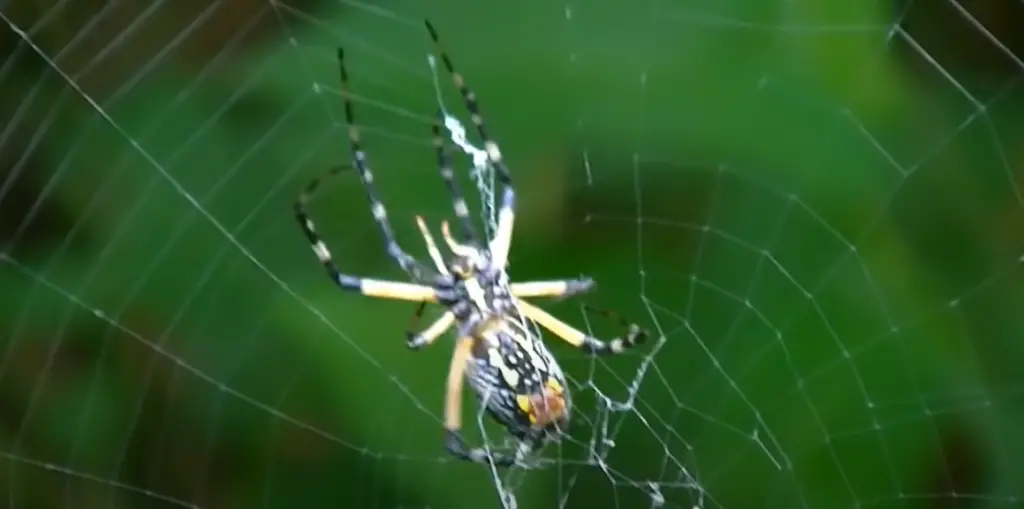
Guide to Banana Spiders (All Types)
Golden silk orb-weaver spiders
Golden silk orb-weavers (Nephila clavipes) are a type of banana spider known for their large and beautiful webs that they use to hunt insects. They can be found in the southeastern United States, Mexico, Central America, and South America. These spiders have bright yellow or golden coloration on their body and legs. The female spiders are much larger than the males, with a body length of up to 1 inch and a leg span of 3 inches! Their webs can be up to 6 feet wide and look like intricate works of art! Golden silk orb-weavers have strong venom which helps them subdue prey quickly. They feed mainly on flying insects such as moths, beetles, bees, and flies.
Marbled orb-weaver spiders
Marbled orb-weavers (Araneus marmoreus) are a type of banana spider found in Europe, Asia, and North America. They typically have triangular bodies with yellowish-brown or grayish coloration, and their legs are usually striped. Female spiders can grow up to 0.5 inches in body length and 1 inch in leg span! Marbled orb-weavers create beautiful webs that look like intricate pictures of pearls, stars, and other shapes. The webs they make also help them capture insects for food; they especially enjoy eating wasps, flies, bees, moths, dragonflies, ants, and grasshoppers.
Cupiennius (Banana Spider)
Cupiennius (Banana Spider) is a type of spider found in Central and South America. They prefer to live in humid, tropical climates and can be found on the underside of leaves or among vegetation. Cupiennius spiders typically have yellowish-brown bodies with white spots along their sides, but their coloration can vary depending on their environment. They have thick legs that are covered with fine hairs which help them climb up surfaces. Cupiennius spiders feed mainly on small insects such as flies, beetles, moths, and ants. Their webs are dense and often resemble a funnel shape when viewed from above – they use these webs to capture prey quickly!
Brazilian wandering spiders
The Brazilian wandering spider (Phoneutria) is a type of banana spider found in tropical climates, mainly in South America. These spiders are usually black with a white or yellowish stripe running the length of their body. They can grow up to 2 inches long and their legs can span a width of 6 inches! The Brazilian wandering spider is known for its aggressive behavior and powerful venom, which it uses to catch prey quickly. These spiders feed mainly on insects such as flies, beetles, moths, and grasshoppers. They do not spin webs; instead, they wander around searching for their food and will attack anything that gets too close!
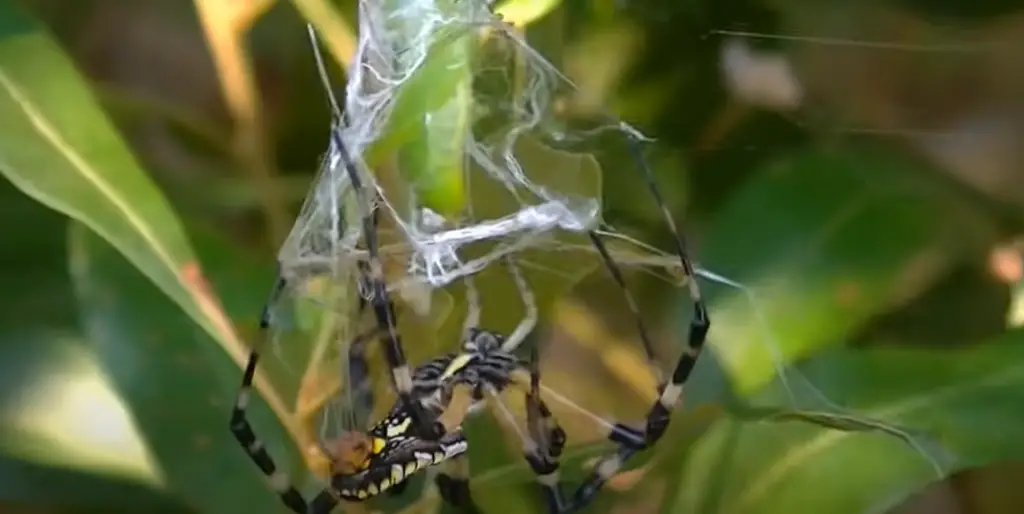
Hawaiian garden spider
The Hawaiian garden spider (Argiope appensa) is a type of banana spider found in Hawaii and other Pacific Islands. These spiders typically have bright yellow bodies with black stripes or spots, and their legs are usually orange or red. They can grow up to 1 inch long and have a leg span of 3 inches! The Hawaiian garden spider builds large webs that look like works of art – they use these webs to capture flying insects such as moths, flies, beetles, and bees for food. These spiders also have powerful venom which helps them subdue prey quickly.
Golden silk-orb weaver
The Golden silk-orb weaver (Nephila clavipes) is a type of banana spider found in the southeastern United States, Mexico, Central America, and South America. These spiders have bright yellow or golden coloration on their bodies and legs. The females are much larger than the males, with a body length of up to 1 inch and a leg span of 3 inches! They build large webs that look like intricate works of art – they use these webs to capture flying insects such as moths, flies, beetles, and bees for food. The venom from their bites can be quite painful but usually isn’t deadly [2].
Common Types of Garden Spiders
Cross Orbweaver
A Cross Orbweaver spider is a type of orb-weaving spider. It gets its name from the cross-shaped web that it builds, which is used to capture prey. These spiders have eight eyes arranged in two rows and they come in a variety of colors such as brown, black, yellow, or orange. Cross Orbweavers create webs with very intricate patterns, often with an X shape in the center, making them easy to identify. They are typically found in gardens and fields and can also be seen near houses and other structures where there are plenty of bugs for them to feed on.
Wolf Spider
Wolf Spiders are another common garden spider found all over the world. They get their name from their wolf-like hunting habits; they are active hunters who will quickly pounce on their prey. They have eight eyes arranged in three rows and generally range from light brown to black. Wolf spiders are usually found under logs, rocks, or debris and can also be spotted near homes and other buildings where food sources are abundant such as insects.
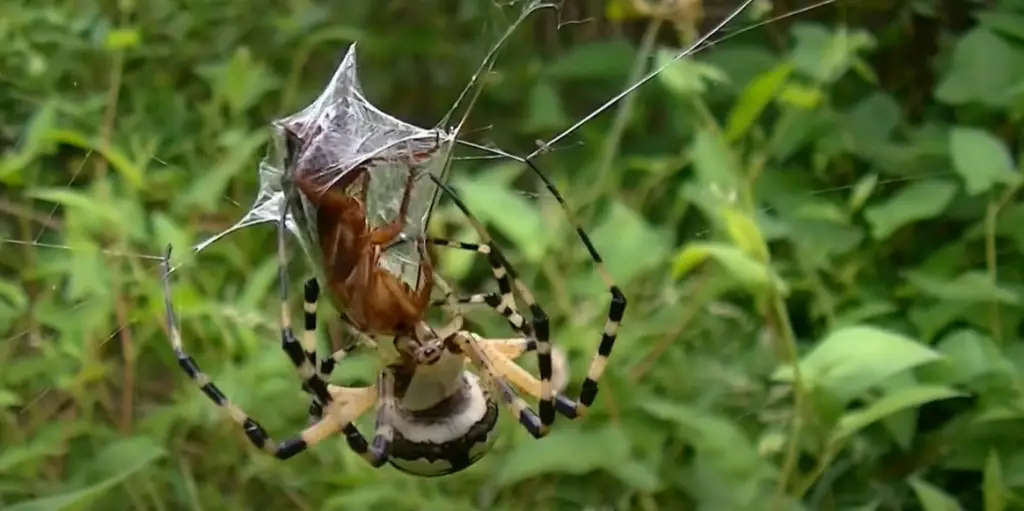
Jumping Spider
Jumping Spiders are a type of spider that gets its name from its jumping behavior. They have four pairs of eyes that make them excellent at detecting movement from far away. These spiders come in a variety of colors such as red, green, brown, black, or orange. Jumping spiders tend to live close to the ground and can often be found near flowers and other plants in the garden. They feed on small insects such as flies, moths, or crickets.
Grass Spider
The Grass Spider is a type of spider that is found in grassy areas and fields. They have long legs and are usually brown or gray. These spiders build webs on the ground near their burrows which they use to capture prey. They feed mainly on insects, but can also feed on small lizards or even frogs if they can catch them. Grass Spiders are active hunters, making them effective at controlling insect populations in gardens and fields.
Goldenrod Crab Spider
The Goldenrod Crab Spider is a type of spider that gets its name from the bright yellow color of its abdomen. These spiders are found in gardens, fields, and meadows throughout the United States and Canada. They do not spin webs to capture prey but instead ambush their victims by hiding on flowers or other plants. They have six eyes arranged in two rows and can change their color from white to yellow depending on which flower they are sitting on.
The Key Differences Between a Banana Spider vs Garden Spider
Size and Color
The most noticeable difference between banana spiders and garden spiders is their size. Banana spiders are much larger than garden spiders, sometimes reaching up to four inches in length. They also have a different coloration; while some species of garden spider may be yellow or orange, most banana spiders tend to be black and white with yellow and red bands on their legs.
Web Building and Habits
Banana spiders build large webs that can span up to 40 feet in diameter. These webs are often made of vertical threads with tangles of sticky silk near the center. Garden spiders, on the other hand, typically build smaller webs that measure only about three feet across. Garden spider webs usually consist of concentric circles interlaced with radial threads. Banana spiders are nocturnal and tend to remain in their webs during the day, while garden spiders are active during the day and build new webs every night.
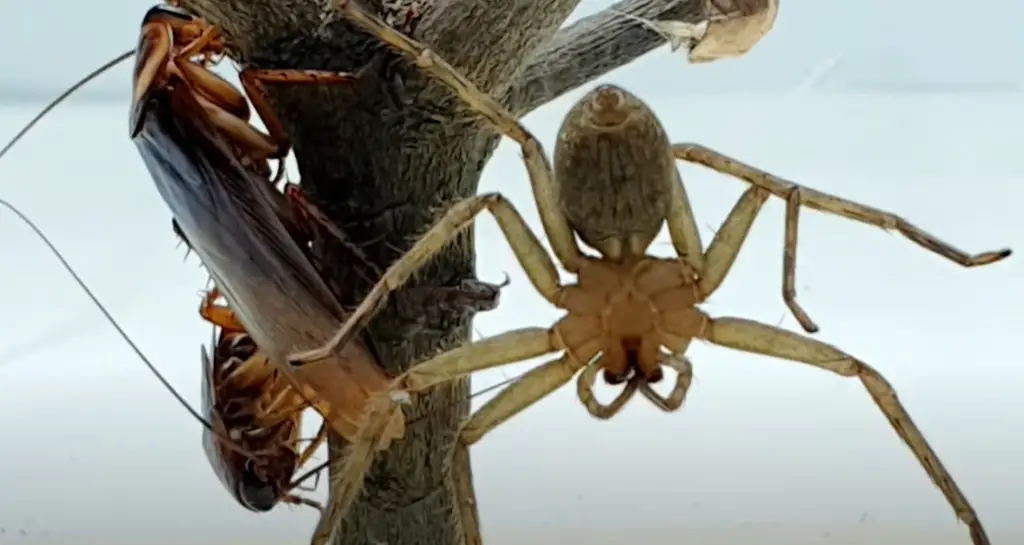
Diet
The two species also differ in what they eat. Banana spiders feed mainly on insects such as moths, flies, and mosquitoes. Garden spiders, however, typically prey upon small invertebrates like aphids, caterpillars, and beetles.
Habitats
Banana spiders usually inhabit tropical regions such as Central America and South America while garden spiders can be found all over the world in areas with warm climates. They often take up residences near gardens or other places where there is plenty of vegetation for shelter and food.
Danger to Humans
It is important to note that while banana spiders are often considered dangerous due to their large size and venomous bite, they rarely attack humans. Garden spiders, on the other hand, have much weaker venom and usually only bite if they feel threatened or disturbed. The bites from both species typically cause minor swelling and discomfort that can be treated with an antibiotic ointment.
Why can yellow spiders be harmful to humans?
Yellow spiders, like most other spiders, have venom that can be harmful to humans. While some yellow spider species may not be dangerous to humans, others can cause a variety of symptoms ranging from mild discomfort to severe illness. The bite of a yellow spider can cause swelling and itching at the bite site and in severe cases, more severe symptoms such as nausea, vomiting, dizziness, and even paralysis. In very rare cases, a yellow spider bite can result in death. It is important to seek medical attention immediately if you think you have been bitten by a yellow spider.
Treatment typically involves administering anti-venom medications or antibiotics depending on the severity of the bite. Additionally, it is important to properly identify any potential yellow spiders before taking action or attempting to capture them. Doing so can help prevent a potentially dangerous encounter with an aggressive spider and mitigate the risk of being bitten.
Why can giant yellow spiders be harmful to your garden?
Giant yellow spiders (also known as banana spiders) can be harmful to your garden because they are capable of producing large webs that can cover large areas and choke off the sunlight needed for plants to thrive. Additionally, these spiders have venomous bites which can cause serious health issues if not treated immediately.
Furthermore, they feed on beneficial insects that help pollinate your plants and keep pests in check. Finally, their webbing can also entangle small pets or children who may accidentally wander into it. All in all, giant yellow spiders pose a danger to your garden and should be avoided if possible.
Measures to avoid having giant yellow spiders in the garden
The best way of avoiding having giant yellow spiders in your garden is to maintain a clean environment. This includes keeping the area free of debris and overgrown vegetation, as this provides an ideal habitat for the spiders. Additionally, spraying pesticides can help reduce the number of these pests in your garden.
Another measure that you can take is to reduce sources of food and water that attract giant yellow spiders, such as bird feeders or open garbage cans. Finally, check any potted plants before bringing them into your home, and dispose of any webs found on trees or shrubs in the backyard. Taking these steps can help ensure that you have a safe and healthy environment for all members of your family, including plants [3]!
FAQ
Are banana spiders on bananas?
No, banana spiders are not actually found on bananas. Although they get their name from the yellowish-orange coloring of some species, banana spiders are typically found in gardens and other outdoor environments. They feed mainly on insects and small invertebrates. If you spot a large yellow spider with black stripes outdoors, chances are it’s a banana spider!
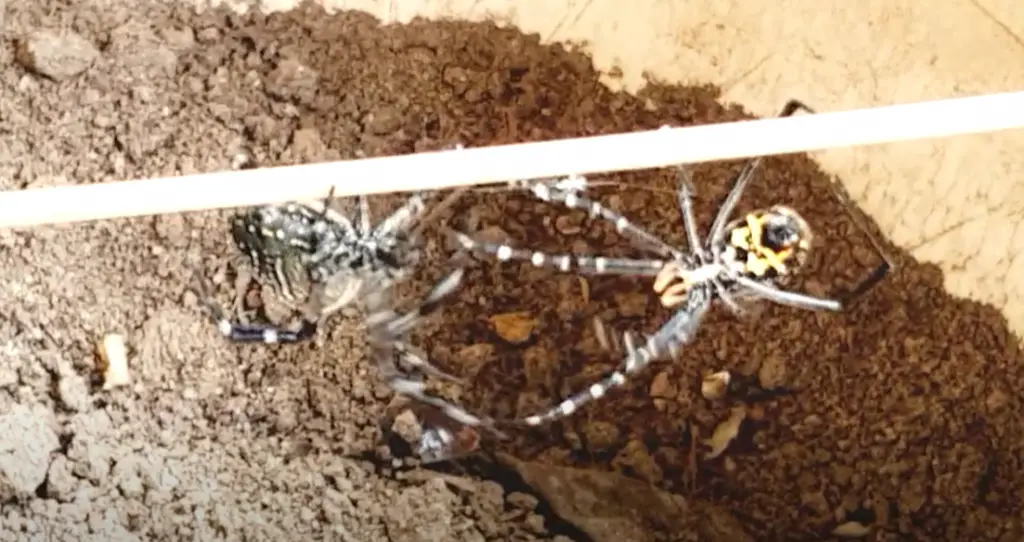
What is another name for a banana spider?
The banana spider is also known as the golden silk orb-weaver. This name comes from the fact that these spiders produce a type of silk that has a golden hue. They weave intricate webs in gardens and other outdoor environments to capture their prey. The webs usually take up an entire area, making them easy to spot!
Do banana spiders bite?
Yes, some species of banana spiders can give a painful bite if they feel threatened or are handled without care. However, their venom is not considered to be dangerous to humans and the pain typically subsides within a few hours. If you ever come across one of these spiders, it’s best to leave it alone and admire it from afar!
Are banana spiders friendly?
Banana spiders are not considered to be dangerous to humans and they typically shy away from people. They are also important predators in terms of controlling insect populations, so it’s best to leave them alone if you happen to spot one outdoors. If you really want to get a closer look at one, try using a long stick or another object to move it into a better viewing position!
What do banana spiders eat?
Banana spiders primarily feed on insects and other small invertebrates. They will also occasionally consume larger prey like lizards or frogs if they can manage to capture them in their webs. They use the silk produced by their abdomens to create intricate webs that help them trap unsuspecting prey. The webs usually span entire areas, making them easy to spot!
Useful Video: BITTEN by a BANANA SPIDER!
Conclusion
Garden Spider and Banana Spider are both essential members of the spider family. Each species plays an important role in their respective ecosystems, preying on other insects and providing food for larger predators. However, these two spiders also have distinct differences. Garden Spiders are usually found near humans, while Banana Spiders are only found in warmer areas such as tropical rainforests. As well as this, the size of the spider and their web is much different between the two species; Garden Spiders create small, circular webs, whereas Banana Spider webs can be quite large and span multiple branches or leaves. While both spiders have an important purpose in nature, it’s important to remember that they should be respected from a distance.
References:
- https://a-z-animals.com/blog/yellow-spiders-joro-spider-vs-garden-spider-vs-banana-spider/
- https://thebuginator.com/banana-spider/
- https://www.pestcontrolgurus.com/the-ultimate-guide-to-banana-spiders/





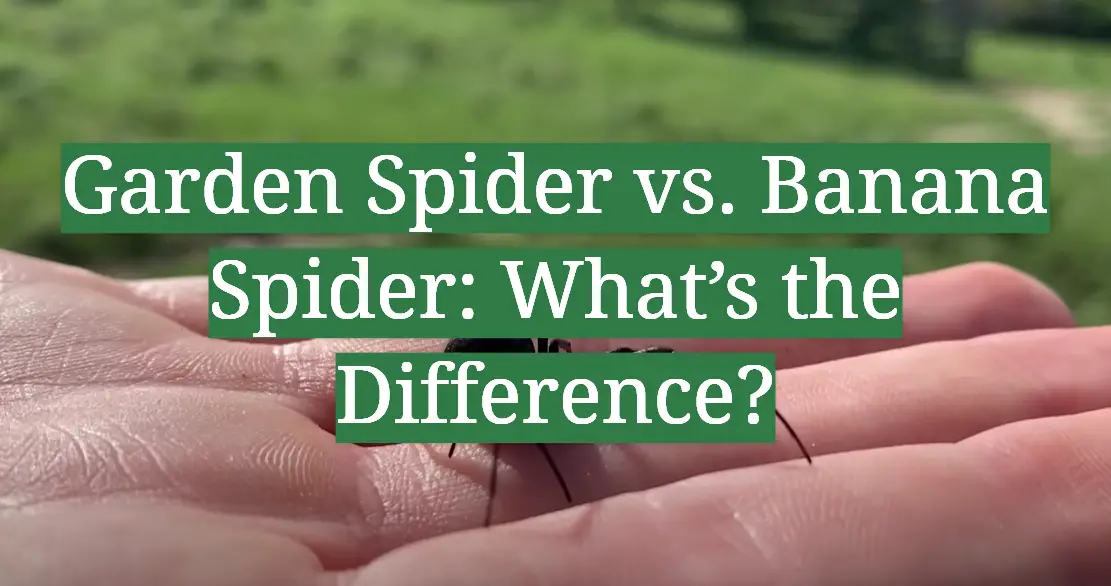

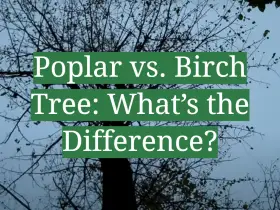

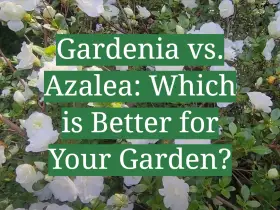
Leave a Reply
View Comments